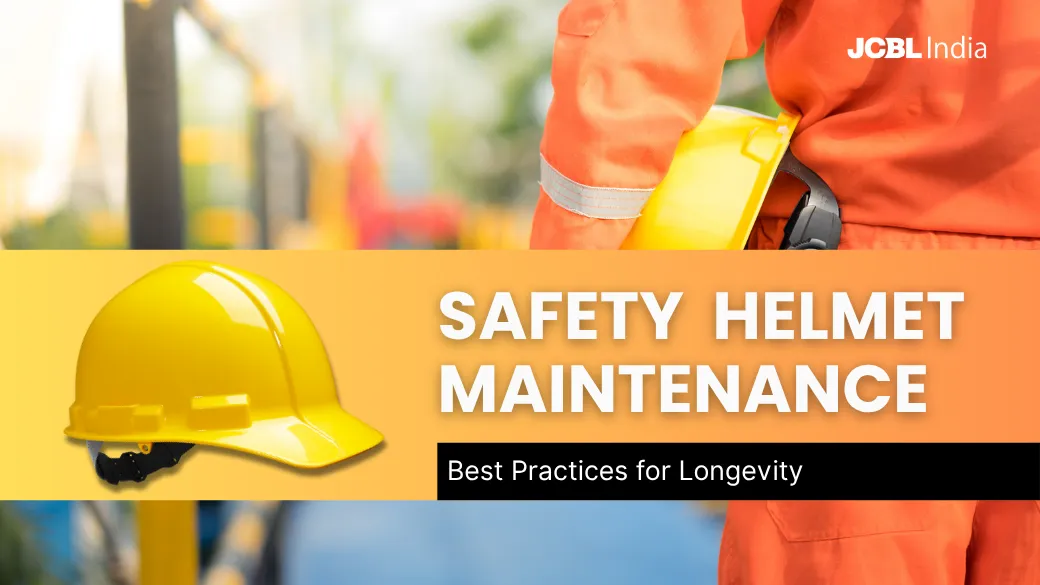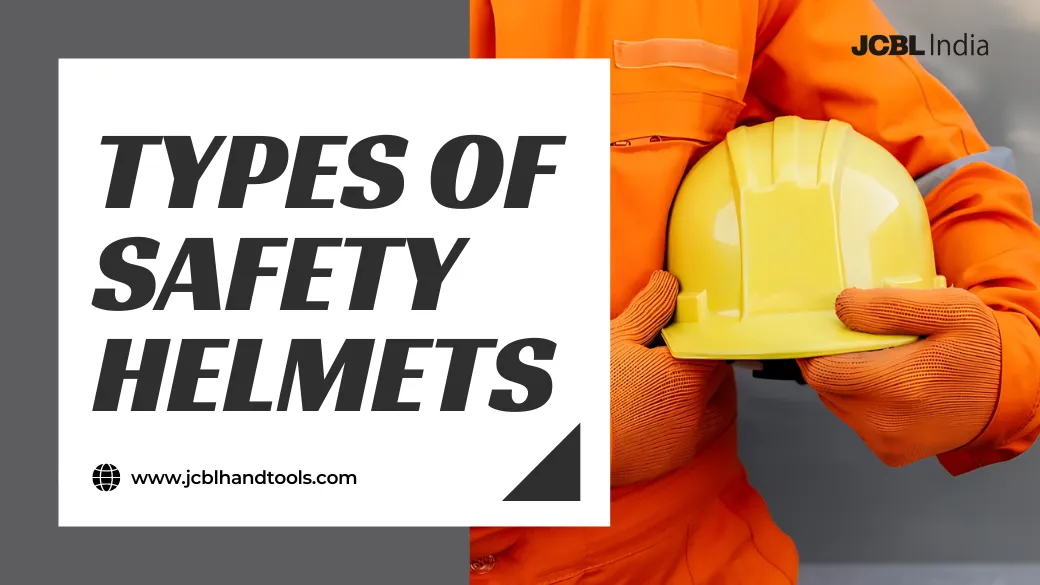Safety Helmet Maintenance: Best Practices for Longevity

Safety helmets are an essential part of personal protective equipment (PPE) in various industries, especially construction, manufacturing, and mining. While investing in high-quality helmets is important, maintaining them correctly is equally vital to ensure their effectiveness and longevity. Proper helmet maintenance not only enhances safety but also reduces the need for frequent replacements, saving both time and money. In this blog, we’ll explore why helmet maintenance is critical, what happens when it’s neglected, and how you can care for your helmet to get the best performance out of it. We’ll also introduce you to JCBL Hand Tools’ range of durable and comfortable safety helmets, designed to offer long-term protection in demanding environments.
Why Helmet Maintenance Is Non-Negotiable
Your safety helmet is the first line of defense against falling objects, electrical hazards, and impact injuries. However, over time, exposure to sunlight, chemicals, moisture, and everyday wear can compromise its structure. Here’s why regular maintenance is essential:
- Ensures continued protection: Microcracks or degraded suspension systems may go unnoticed without regular checks, but can significantly reduce impact resistance.
- Complies with safety regulations: Many industry standards require regular inspection and maintenance of PPE to ensure workplace compliance.
- Extends product lifespan: Proper care helps avoid early replacements and increases the helmet’s usable life.
- Boosts worker confidence: Workers are more likely to wear PPE that is clean, comfortable, and in good condition.
Also Read: Types Of Safety Helmets!
What Happens When You Ignore Helmet Care?
Neglecting helmet maintenance may seem harmless initially, but the long-term effects can be dangerous and costly:
- Compromised safety: A damaged shell or worn-out suspension won’t absorb shock effectively, increasing the risk of injury.
- Increased liability: Employers could be held responsible for injuries caused by defective PPE.
- Shortened lifespan: Dirt, chemicals, and UV exposure accelerate material degradation.
- Poor hygiene: Sweat accumulation and unclean surfaces can lead to odor, skin irritation, and infections.
Ignoring regular inspections can turn a lifesaving device into a false sense of security.
Understanding Your Safety Helmet: Key Components to Watch
To ensure the proper maintenance and care of a safety helmet, first, it’s important to understand safety helmets, its key components and how they function:
Outer Shell
The outer shell is the outside, hard part of the helmet. This is made with durable materials like high-density polyethylene (HDPE), low-density polyethylene (LDPE), or ABS plastic. It is important to regularly inspect it for cracks, dents, discoloration, or brittleness, especially after exposure to sunlight or chemicals. A damaged shell can compromise protection and should be replaced immediately to maintain safety standards.
Suspension System
The suspension system inside the helmet includes headbands and straps that absorb shock during impact. Over time, these parts may fray, lose elasticity, or break. Routine checks ensure the system remains secure and effective. Replace any worn components to maintain comfort, stability, and overall protective performance during demanding tasks.
Sweatband and Padding
Sweatbands and inner padding provide comfort and absorb perspiration during long working hours. When they become stained, smelly, or worn out, they can cause irritation and reduce wearability. Replacing them regularly ensures hygiene, maintains comfort, and encourages consistent helmet usage, especially in hot or high-intensity work environments.
Chin Strap
A chin strap keeps the helmet securely on your head during movement or sudden jolts. Over time, the strap or buckle may weaken, fray, or break, leading to poor fit or safety risks. Inspect it routinely and replace it at the first sign of damage to ensure your helmet stays firmly in place.
Adjustment Mechanism
Adjustment systems—such as ratchet or pin-lock mechanisms—allow for a snug, personalized helmet fit. If the system becomes stiff, slips, or fails to hold tension, it compromises safety and comfort. Regular testing ensures proper function, while timely replacement prevents the helmet from shifting or falling off during critical moments.
Best Practices for Helmet Maintenance and Longevity
To maximize your helmet’s lifespan and maintain its protective capabilities, adopt these best practices:
Daily Visual Inspections
Start each workday by inspecting your helmet for visible damage. Check the outer shell for cracks, dents, or discoloration. Examine the suspension system and chin straps to ensure they fit correctly and are not frayed or broken. Regular daily checks catch early signs of wear before they become serious issues.
Monthly Deep Clean
Clean your helmet thoroughly at least once a month. Use mild soap and warm water to wash the shell; avoid harsh chemicals or abrasive brushes. Remove and clean the sweatband or padding, replacing if needed. Always let the helmet air-dry in a shaded area—never use direct heat, which can damage it.
Proper Storage
When not in use, store your helmet in a cool, dry place, away from direct sunlight, moisture, or chemicals. Avoid tossing it around or leaving it on unsafe surfaces. Use a helmet bag or dedicated shelf to keep it safe from accidental damage, helping preserve its structure and reliability.
Label and Track Usage
Label your helmet with the issue date and user information to track its service life. Maintain a simple logbook or digital record for periodic inspections and cleanings. Tracking helps ensure timely replacements, builds accountability, and supports better inventory and maintenance planning across your team or organization.
Avoid Alterations
Never paint your helmet or apply unauthorized stickers, as this can weaken the plastic or conceal cracks. Modifications can void the manufacturer’s safety certifications and compromise performance. Always follow manufacturer guidelines for accessories or branding to ensure the helmet maintains its integrity and protective capabilities.
Training and Awareness
Regularly conduct short training sessions or toolbox talks to reinforce the importance of helmet maintenance. Encourage team members to report discomfort or damage early. Cultivating a safety-first mindset ensures every worker understands the value of their protective gear and contributes to a stronger workplace safety culture.
When to Replace Your Helmet
No helmet lasts forever. Here’s when you should consider replacing your safety helmet:
- Every 3-5 years, depending on manufacturer guidelines and usage conditions.
- After a significant impact, even if there’s no visible damage.
- If the shell shows cracks, brittleness, or discoloration.
- If the suspension system loses its elasticity or snaps.
- If parts like sweatbands or chin straps are worn beyond repair.
Follow a simple rule: If in doubt, swap it out. Better safe than sorry.
JCBL Hand Tools: Your Trusted Supplier of Safety Helmets
When it comes to durability, innovation, and ergonomic design, JCBL Hand Tools leads the way in safety helmet solutions. Our product range is engineered for different work environments and job roles while keeping comfort and protection as top priorities.
- J-7000 Series: Engineered with virgin HDPE, the J-7000 series offers superior impact resistance and enhanced neck protection. Ideal for supervisors, engineers, and high-risk industrial environments with added ventilation and ARC compatibility.
- J-6000 Series: Designed for medium-duty tasks, J-6000 series features a 6-point suspension and excellent upward visibility. Available with ventilation and adjustment options, it’s perfect for factory supervisors and maintenance workers.
- J-8000R: Built for rugged environments, the J-8000R delivers maximum impact resistance and an 8-point suspension system. It includes universal slots for accessories and a sweat-absorbing band for all-day comfort.
- J-9000R: A robust, lightweight helmet with a wide protective peak and durable crown corrugation. The J-9000R suits heavy-duty professionals requiring long wear with reliable safety and compatibility features.
- J-ECOSAFE: J-ECOSAFE is a budget-friendly option offering lightweight comfort and essential protection for general industry use. Its replaceable cradle and 6-point LDPE support make it ideal for extended wear without fatigue.
Each helmet is engineered with quality materials and thoughtful features to ensure it stands the test of time, with proper maintenance. Explore JCBL Hand Tools’ safety helmet range today and invest in protection that lasts.
Conclusion
When it comes to workplace safety, your helmet is your first line of defense—and like any protective gear, it demands regular care. From daily visual inspections to monthly deep cleans and proper storage, helmet maintenance isn’t just about longevity, it’s about ensuring maximum protection every time you wear it. Neglecting this essential safety gear can lead to unseen damage, reduced impact resistance, and even serious injury in case of an accident. That’s why understanding your helmet’s key components and following best practices is not optional—it’s a safety responsibility.
Choosing the right helmet is equally important. With JCBL Hand Tools, you not only get top-tier protection but also innovative design, comfort, and reliability. Whether you’re working on construction sites, in factories, or high-risk industrial environments, JCBL’s range of helmets is engineered to meet your specific needs and withstand tough conditions.
Prioritize safety that lasts—choose JCBL Hand Tools for certified protection and long-term performance.
Browse the complete safety helmet collection and equip your workforce with gear they can truly rely on.
For any queries, contact us at +91-9815579321 or email us at handtools@jcbl.com.
FAQs
How often should I inspect my safety helmet?
It’s recommended to perform daily visual inspections before each use to check for cracks, dents, or worn-out straps. In addition, conduct a monthly deep clean and inspection to ensure all components are intact and functioning properly.
Can I clean my helmet with strong detergents or solvents?
No. Avoid using harsh chemicals, solvents, or abrasive cleaners as they can weaken the shell material. Always use mild soap and warm water, and let the helmet air dry—never use direct heat.
When should I replace my safety helmet?
Replace your helmet if it has visible damage, has been involved in a significant impact, or shows signs of wear and aging such as brittleness or fading. Even without visible damage, most manufacturers recommend replacing helmets every 3–5 years depending on usage and environment.



